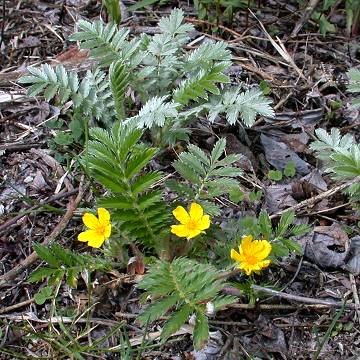

Potentilla anserina - (image 1 of 6)
Taxonomy
Family: Rosaceae
Habitat
In a variety of sandy soils near Lake Michigan. Calcareous flat marshes. Gravels bars.
Associates
On the shores of interdunal ponds with Agalinis purpurea, Gentiana crinita, Hyperisum kalmaianum, Lobelia kalmii, Parnassia glauca, Rhynchospora capillacea, Sabatia angularis, Solidago ohioensis, Triglochin maritima.
Distribution
Northern tier of the eastern US and most western states and north into Canada to the arctic.
Morphology
Low, creeping, herbaceous perennial. Leaves basal, densely silvery-sericeous beneath, pinnate compound; leaflets sharply toothed, principle leaflets alternating with much reduced ones. Flowers bright yellow, to 1" wide; petals 5, blunt; stamens and pistils numerous. Fruit dry, seed-like.
Notes
Flowers mid May to early October
Wetland indicator: Facultative Wetland +
Most attractive in spring when the new foliage is silvery green. The roots are edible, said to resemble parsnips or sweet potatoes in taste when boiled.
References
Niering, W. A. 1979. The Audubon society field guide to North American
wildflowers: eastern region.
Knopf/Random House, New York.
Swink, F. and G. Wilhelm. 1994. Plants of the Chicago Region.
Indiana Academy of Science. The Morton Arboretum. Lisle, Illinois.
USDA, NRCS. 2002.
The PLANTS Database, Version 3.5 (http://plants.usda.gov).
National Plant Data Center, Baton Rouge, LA 70874-4490 USA.
|
Michael Hough © 2005 |